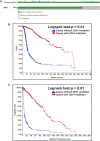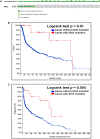Isocitrate Dehydrogenase IDH1 and IDH2 Mutations in Human Cancer: Prognostic Implications for Gliomas
- PMID: 35996504
- PMCID: PMC8915566
- DOI: 10.3389/bjbs.2021.10208
Isocitrate Dehydrogenase IDH1 and IDH2 Mutations in Human Cancer: Prognostic Implications for Gliomas
Abstract
Background: There are isolated reports of mutations in genes for isocitrate dehydrogenases (IDH1 and IDH2), but few have been examined in a large number of different malignancies. We aimed to analyze mutational prevalence of these genes in a large series of cancers and determine their significance in most mutated phenotype. Methods: We analyzed the frequencies of IDH1 and IDH2 mutations in 14,726 malignancies of 37 cancers. Furthermore, we examined these mutations in the most frequent cancer (gliomas, 923 cases) from a single cohort, and determined their clinical significance. Results: IDH1 mutations were present in 3% (473/14,726) of cancers. The highest frequencies were in oligodendrogliomas (91/102, 89%), anaplastic oligodendrogliomas (40/46, 87%), and diffuse astrocytomas (89/116, 77%). IDH2 mutation was detected in <1% (83/14,726) of cancers, but were present in 13% (6/46) of anaplastic oligodendrogliomas, 9% (9/102) of oligodendrogliomas, and in 5% (2/39) of cutaneous squamous cell carcinomas. Further analyses of 923 gliomas revealed 34 and 1% of IDH1 and IDH2 mutations, respectively. In up to 342 months of follow-up, IDH1 and IDH2 mutations were significantly linked with better overall (OS) (both p = 0.01) and progression-free survival (PFS) (p = 0.01; p = 0.004), respectively. Conclusion: IDH1 and IDH2 are often mutated in a tissue-specific manner, most commonly in gliomas. Mutation in both genes is linked to OS and PFS. Our findings suggest that these genes are promising therapeutic targets and strong prognostic biomarkers in gliomas.
Keywords: IDH1; IDH2; cancer; dehydrogenase; glioma; isocitrate; mutation.
Copyright © 2022 Murugan and Alzahrani.
Conflict of interest statement
The authors declare that the research was conducted in the absence of any commercial or financial relationships that could be construed as a potential conflict of interest.
Figures


Similar articles
-
Type and frequency of IDH1 and IDH2 mutations are related to astrocytic and oligodendroglial differentiation and age: a study of 1,010 diffuse gliomas.Acta Neuropathol. 2009 Oct;118(4):469-74. doi: 10.1007/s00401-009-0561-9. Epub 2009 Jun 25. Acta Neuropathol. 2009. PMID: 19554337
-
Estimation of the occurrence rates of IDH1 and IDH2 mutations in gliomas and the reconsideration of IDH-wildtype anaplastic astrocytomas: an institutional experience.J Int Med Res. 2021 Jun;49(6):3000605211019258. doi: 10.1177/03000605211019258. J Int Med Res. 2021. PMID: 34162262 Free PMC article.
-
Clinico-neuropathological features of isocitrate dehydrogenase 2 gene mutations in lower-grade gliomas.Chin Med J (Engl). 2019 Dec 20;132(24):2920-2926. doi: 10.1097/CM9.0000000000000565. Chin Med J (Engl). 2019. PMID: 31833906 Free PMC article.
-
Isocitrate dehydrogenase-1 mutations: a fundamentally new understanding of diffuse glioma?Lancet Oncol. 2011 Jan;12(1):83-91. doi: 10.1016/S1470-2045(10)70053-X. Epub 2010 Jul 7. Lancet Oncol. 2011. PMID: 20615753 Review.
-
Association Between IDH1 and IDH2 Mutations and Preoperative Seizures in Patients with Low-Grade Versus High-Grade Glioma: A Systematic Review and Meta-Analysis.World Neurosurg. 2018 Mar;111:e539-e545. doi: 10.1016/j.wneu.2017.12.112. Epub 2017 Dec 27. World Neurosurg. 2018. PMID: 29288860
Cited by
-
Mitochondrial Dysfunction: A Cellular and Molecular Hub in Pathology of Metabolic Diseases and Infection.J Clin Med. 2023 Apr 14;12(8):2882. doi: 10.3390/jcm12082882. J Clin Med. 2023. PMID: 37109219 Free PMC article. Review.
-
Catalytically distinct metabolic enzyme isocitrate dehydrogenase 1 mutants tune phenotype severity in tumor models.J Biol Chem. 2025 May;301(5):108477. doi: 10.1016/j.jbc.2025.108477. Epub 2025 Apr 4. J Biol Chem. 2025. PMID: 40188944 Free PMC article.
-
Predictive and Prognostic Significance of Molecular Biomarkers in Glioblastoma.Biomedicines. 2024 Nov 22;12(12):2664. doi: 10.3390/biomedicines12122664. Biomedicines. 2024. PMID: 39767571 Free PMC article. Review.
-
IDH mutation and MGMT methylation status in glioblastoma and other gliomas patients: a Russian retrospective cohort study.J Egypt Natl Canc Inst. 2025 May 16;37(1):36. doi: 10.1186/s43046-025-00296-w. J Egypt Natl Canc Inst. 2025. PMID: 40377745
-
The Interplay between Dysregulated Metabolism and Epigenetics in Cancer.Biomolecules. 2023 Jun 5;13(6):944. doi: 10.3390/biom13060944. Biomolecules. 2023. PMID: 37371524 Free PMC article. Review.
References
MeSH terms
Substances
LinkOut - more resources
Full Text Sources
Medical
Miscellaneous

